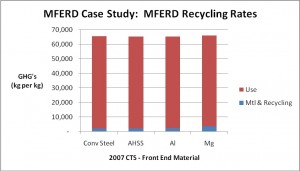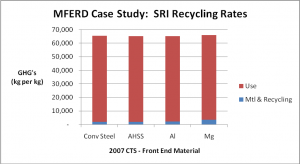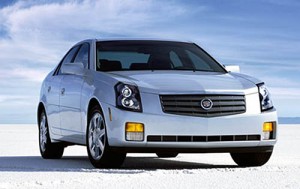The Magnesium Front End Research Development (MFERD) project was initiated in 2007 to develop key enabling technologies that would fuel growth of magnesium automotive applications. MFERD is sponsored by Natural Resources Canada, the Chinese Ministry of Science and Technology, the United States Department of Energy and the United States Automotive Materials Partnership. The project included a life cycle assessment of various front-end materials and designs, utilizing a 2007 GM Cadillac CTS sedan as the reference vehicle.
The Life Cycle Assessment (LCA) study compared the environmental performance of the current steel front end, a lightweight magnesium front end structure, and an aluminium design, summarized in a 2010 SAE Technical Paper (No.980470). Material and fabrication costs were not part of the work scope. Please note that the 2007 CTS sedan was launched in 2003, with little change to the body structure or subsystem materials during its product cycle.
The MFERD study concluded that large magnesium structural parts can provide environmental benefits in terms of energy use and GHG emissions within the expected life of the car. It also reported that overall, the aluminium design was “better at achieving the breakeven distance from energy use and GHG emissions perspectives within the vehicle life.”
LIFE CYCLE ASSESSMENT PARAMETERS
Table 1 (below) summarizes the MFERD study’s material and life cycle component emissions associated with the component only. Here, use phase emissions are based on primary and secondary vehicle mass reductions from the component change; the ratio of component mass to overall vehicle mass determines the percent emissions reduction associated with component mass reduction, which overstates use phase savings. This table clearly shows the life cycle emissions reductions of aluminium or magnesium compared to the baseline steel front end structure in the reference vehicle. Included in this table is an estimate for component emissions reductions associated with an advanced high strength steel front-end design, following the MFERD methodology.
|
Table 1: MFERD Materials and Component Emissions Comparisons |
||||||
|
Front End Structure |
Mass (kg) |
Mass Savings (kg) |
Production GHG’s (kg) |
Use Phase GHGs (kg) |
Recycling Credit (kg) |
Life Cycle GHGs (kg) |
|
Steel – Baseline |
82.2 |
— |
328 |
3,726 |
-123 |
3,931 |
|
Magnesium |
45.2 |
37.0 |
2,039 |
2,075 |
-642 |
3,472 |
|
Aluminium |
61.0 |
21.2 |
829 |
2,785 |
-460 |
2,972 |
|
AHSS (-15%) est
|
69.6 |
12.3 |
280 |
3,170 |
-105 |
3,345 |
In contrast, the UCSB GHG Materials Comparison Model* studies the materials impact to vehicle emissions, and thus is a more comprehensive and accurate accounting for the differences achieved via vehicle components substitution. It is important to note that the UCSB model does not include emissions from material transportation and component fabrication, which are reflected in the component table above. Our assumption is that there is little difference in these values, compared to the emissions differences found in material production and the use phase.
The objective of this Case Study is to reproduce the MFERD study within the UCSB model, to determine if the vehicle emissions impacts from various materials are different than their component study would suggest.
Some notable parameters from MFERD that affect results:
- Driving Cycle: the MFERD study used the EPA Mobile 6 programme to determine use phase emissions. The UCSB model does not have this capability; instead, our default selection is the HYZEM driving cycle, because it is an accurate reflection of real consumer driving practices in both urban and rural settings.
- Weight Elasticity: the MFERD study utilizes the incremental approach, and derives a reduction in fuel ranging from 0.6 to 0.8 l/100km. Fka conducted weight elasticity studies and determined that this range is comparable when powertrain res-sizing is considered.
- Material Emissions Factors: the MFERD study used the worldsteel global LCI for steel production emissions, however they “Americanized” the IAI LCI by substituting U.S. LCI database process data on electricity and fuel combustion. These values probably result in higher emissions factors for aluminium owing to the U.S. dependence on coal, as opposed to the current IAI global LCI, which omits China from their database.
- Recycling Rates: the MFERD study assumes a vehicle collection rate of 94%, shredder efficiency of 95% and metal recovery rate of 95%, and applies these rates consistently among the steel, magnesium and aluminium materials. The American Iron and Steel Institute’s Steel Recycling Institute disagrees with these rates, and their studies show dissimilar values for the different materials (noted below in Table 2). Our Case Study explores both scenarios, with emissions results shown in both Table 3 and the subsequent Vehicle Life Cycle emissions charts.
|
Table 2: UCSB Model Parameters Used |
|
| Vehicle Curb Weight | 1595 kg |
| Mass of Removed Replaced | 82.2 kg |
| Powertrain | ICE-Gasoline; ethanol content: 0% |
| Powertrain Resizing? | Yes |
| Secondary Mass Reduction | 50% |
| Fuel Consumption | 0.1281 l/km (0.66 fuel reduction value) |
| Driving Cycle | Hyzem |
| Lifetime Driving Distance | 200,000 km / 124,321 miles |
| Steel Composition | 90% hot-dip galvanized, 10% CR |
| SRI Recycling Rates: | |
| Steel (conv and AHSS) | 97% collection, 98% shredder efficiency, 95% metal recovery |
| Aluminium | 97% collection, 90% shredder efficiency, 90% metal recovery |
| Magnesium | 97% collection, 90% shredder efficiency, 90% metal recovery |
| Manufacturing Yields: | |
| Steel (conv and AHSS) | 71.4% stamping |
| Aluminium | 71.4% stamping, 80% casting and extrusion |
| Magnesium | 71.4% stamping, 76% casting and extrusion |
| Magnesium Production Process | 80% Pidgeon, 20% Electrolytic |
In the Materials tab of the UCSB Model, the Pidgeon or Electrolytic magnesium production processes must be specified. The MFERD study reported a 4-1 ratio for the Pidgeon vs. Electrolytic process, which is the same ratio selected in this Case Study.
AHSS Mass Reduction Potential. The UltraLight Family of Research (www.worldautosteel.org), as well as industry practice, shows that a 25% mass reduction can be achieved with AHSS compared to conventional mild steel. Optimisation techniques have yielded even greater light weighting potential. In this application, we apply a conservative 15% mass reduction value, with the assumption that the 2007 CTS steel front end utilised best fabrication technology during its development.
| Table 3: 2007 CTS – Magnesium Front End – UCSB Materials Comparison Model Life Cycle Emissions Comparing Impact of MFERD and UCSB Recycling Rates | ||||||
|
Front End Material |
Production | Use | MFERDRecycling | Life Cycle | SRI-UCSBRecycling | Life Cycle |
| Conventional steel |
3,295 |
63,592 |
(1,308) |
65,579 |
(1,330) |
65,557 |
| AHSS |
3,240 |
63,242 |
(1,336) |
65,326 |
(1,401) |
65,261 |
| Aluminium |
3,995 |
62,990 |
(1,751) |
65,234 |
(1,781) |
65,205 |
| Magnesium |
6,156 |
62,543 |
(2,293) |
66,506 |
(2,743) |
66,004 |
 |
 |
CONCLUSIONS
Because of differences between the MFERD and UCSB models, including driving cycles, we were not able to reproduce the MFERD findings. Nevertheless, the UCSB Model leads to the following conclusions:
- A life cycle assessment of automotive component-related emissions should be embedded in a full Vehicle Emissions model, as otherwise there is great potential to understate the use phase emissions.
- The AHSS solution is the only one that achieves reductions in mass, production emissions and use phase emissions. AHSS and aluminium show comparable life cycle emissions performance (within the accuracy of the model), especially when more realistic recycling rates are applied for aluminium. Convergence does not occur until materials recycling credits are added at end-of-life. Likewise, the magnesium front-end vehicle has higher emissions throughout its life, despite the addition of generous recycling credits at end-of-life.
- In the MFERD study, the recovery and shredder efficiency rates were set at the same values for all three materials. Part processing efficiency (stamping yields) varied slightly, and were equivalent for steel and aluminium; our experience is that aluminium processes result in higher scrap levels, or lower yields. Finally, it’s important to note that a high percentage of recycling is a fundamental requirement of the energy-intensive materials (magnesium and aluminium), in order to offset their production emissions. Small changes in their recycling rates will have a large impact on GHG emissions.
- The use of advanced powertrains (such as hybrids), advanced fuels (such as grain and cellulose ethanols) and improved driving cycles (such as the implementation of timed lights and roundabouts) can result in a dramatic reduction in use phase GHG emissions. Consequently, material production emissions will become a much more significant percentage of the total LCA GHG emissions as use phase efficiencies are achieved.
- As a result of the differences in use phase modeling between the UCSB model and the MFERD study, WorldAutoSteel has engaged the MFERD project team, and has established a partnership referred to as LCA in Automotive. We will be working together on future multi-material vehicle concepts, to bring common methodologies and practices forward on the assessment of materials impact to vehicle lifetime emissions, all from an LCA perspective.

